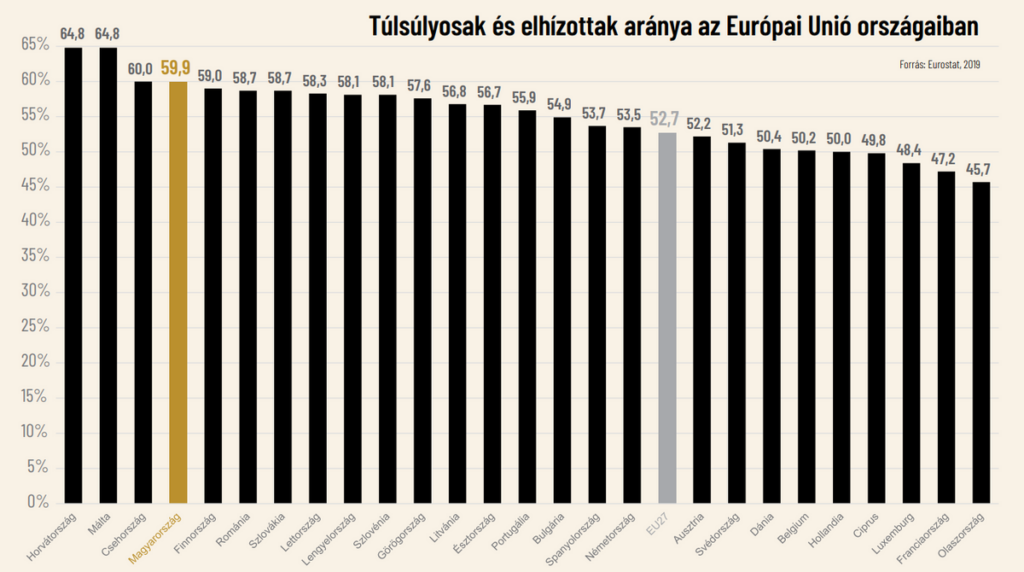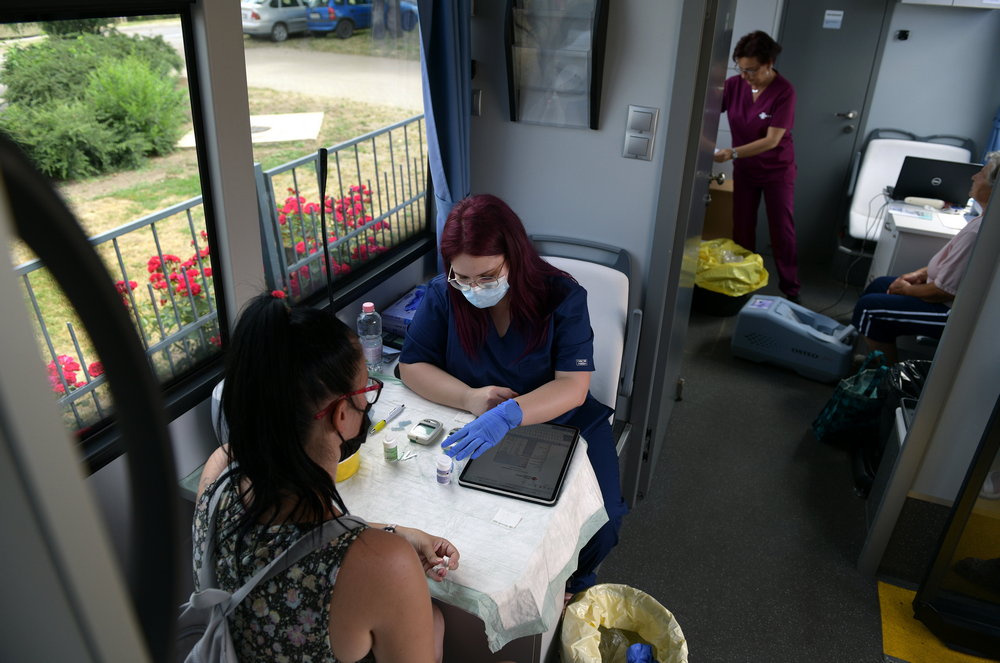The national public health strategy has been prepared, the goal is to increase the number of healthy years of Hungarians.
There is room for improvement, mortality statistics are kept for many diseases. We looked at what problems the government has identified and what goals it has set.
We drink, smoke, are overweight, and die early - the sight of the state of health of Hungarians is deplorable. Although healthy lifestyles are receiving more attention than ever before, there is no significant improvement at home.
However, if we really want a demographic turnaround, we should not only increase the number of births, but also the number of years lived in good health. The health administration also recognized this and asked the National Association of Public Health Training and Research Sites to prepare a comprehensive strategy for the purpose of analyzing the situation and setting tasks. In September, Professor Róza Ádány, the founding president of the association, spoke about how the document deals, among other things, with maternal and child protection, youth health protection, the health of the elderly, preventive dental care, musculoskeletal and mental health, cancer diseases, and primary care and by strengthening other sectors of health care.
"Success can only be hoped for if different sectors of society, governmental and non-governmental organizations stand behind the program"
Róza Ádány drew attention.

Photo: Pixabay
Many years behind, unhealthy lifestyle
The strategy first points out that since 1981, Hungary has been among the countries with a declining population, which can be traced back to the low number of births and the high number of deaths on the other hand. Along with other states, population decline is accompanied by a change in the age structure of the population. In our country, the proportion of people over 65 was 5.6 in 1920, 13 in 1990, 19.9 in 2020, and 20.3 in 2022, and according to forecasts, it may reach 30 percent by 2050.
Life expectancy at birth has also long shown an unfavorable picture: between 1988 and 1993, it decreased in the case of Hungarian men - in a unique way in Europe - and although it showed a slight but practically consistent increase for women since 1980 and for men since 1994, it is far behind for both sexes. not only from the leading countries, but also from the indicators of the Czech Republic, Poland and Slovakia with a similar historical fate. This moderately increasing trend continued until 2019, but the excess mortality caused by the coronavirus epidemic broke it, and in 2020 life expectancy at birth decreased, similar to the average of the EU member states and Switzerland. But in Switzerland, the indicator returned to its previous value in 2021, and in Austria it remained unchanged, while in Hungary - similarly to the figures in the Czech Republic, Slovakia and Poland - a further decrease was observed. According to Eurostat data, the life expectancy at birth in Hungary fell from 76.5 years in 2019 to 75.7 years in 2020, and to 74.5 years in 2021. Based on the evolution of life expectancy at birth in 2021, only Latvia, Romania and Bulgaria had worse indicators than our country among the EU member states; our lag behind the EU average was 6.7 years.
And why do we die earlier? According to the strategy, in 2019, 33.4 percent of deaths in the 25-64 age group were caused by cancer and 33 percent by diseases of the circulatory system. For women, the rank of cause of death is similar; in their case, the death due to tumors was 46.6 percent.
In terms of premature death caused by the latter diseases, we are in an unfavorable position in an international comparison: in terms of men, we are in second place after Mongolia, and among the OECD member countries, Hungary's indicators are the most unfavorable for women. Otherwise, lung cancer is the most common cause of premature death in both sexes, followed by deaths caused by cancers of the colon and rectum and tumors of the lip, oral cavity and pharynx in the case of men, and deaths caused by tumors of the breast and colon and rectum in the case of women. The document also mentions that our country ranks first in the world in terms of deaths caused by lung cancer and pancreatic cancer.

The strategy refers to the most recent health survey conducted in 2019, based on which more than 65.5 percent of the adult population classified their health status as good or very good. Compared to this, 60 percent of the Hungarian population aged 15 and older was overweight or obese, and almost a quarter smoked on a daily basis, which is only minimally lower than the value in 2014. Compared to the results of the survey ten years ago, there was no change in the frequency of uncontrolled alcohol consumption,
In 2019, the estimated proportion of heavy drinkers was 5 percent
- 10 percent among men, 1-2 percent among women. Only 8 percent of those surveyed said that their consumption habits correspond to the criteria defined by the World Health Organization in relation to healthy nutrition. In terms of leisure-time physical activity, the situation clearly worsened in 2019 compared to five years earlier: 54 percent of the population aged 15 and older did not play sports at all, and only 23 percent did at least 150 minutes of leisure-time exercise per week – in 2014, these proportions were 43, and they stood at 29 percent.
Premature birth, childhood obesity and an overburdened care system
The government formulated several radical objectives in the mentioned areas. In the field of mother and child protection, for example, he emphasizes that the quality of women's protection and pregnancy care activities within the midwifery care needs to be improved, that the average number of visits to antenatal counseling should be at least six in the case of pregnant women who have some kind of hindering health and/or or there is a social reason.
"The premature birth rate must be reduced below 8 percent"
- they draw attention, noting that in recent years this proportion has remained consistently high, hovering around 9 percent. They also mentioned that the unfavorable trend of childhood overweight and obesity must also be reversed, and that it will be necessary to reorganize the mobile specialist service and/or organize the human resources background of mobile childhood screening tests and prevention services.
Regarding the elderly, the strategy points out that the "unsuccessful" aging of Hungarian society is one of the country's most significant social and economic challenges. Due to the extremely high incidence of chronic diseases related to aging, the aging and elderly population more often use not only the services of basic and outpatient specialist care, but also inpatient care and social institutions, which puts a huge burden on the health care, social care system and the pension system. It is emphasized that one of the specific objectives of the new public health program is the organization of health promotion and community care for the elderly, the creation of jobs and workplaces that ensure this, and the creation of the resources necessary for these goals.

Photo: Pixabay
It will be necessary, among other things, to develop a comprehensive program for the health promotion offices, covering every detail of the health promotion of the elderly, with the involvement of universities. The document also deals with socially vulnerable groups, and states that the most important goal is to improve care system problems that hinder access to health care, primarily affecting people at risk of social exclusion. Thus, for example, specialists must be provided in the permanently vacant family doctor and nurse districts; health promotion offices must be established in all disadvantaged districts; the age-related screening tests must be completed in full; and regular kindergarten and school health promotion programs should be organized to improve physical and mental health.
The comprehensive filter program is coming
In Hungary, we can count on 100,000 new cancer cases every year,
and the number of deaths is around 31-32 thousand. According to data from Eurostat and the Global Cancer Observatory, among the member states of the European Union in 2019, our country had the highest rate of premature death due to cancer - another serious statistic can be read in the chapter dealing with the prevention of cancer. According to the analyses, 42 percent of cancer cases and 45.1 percent of cancer deaths can be attributed to, among other things, one of the risk factors – but even more so a combination – such as active or passive smoking, overweight/obesity, physical inactivity, excessive alcohol consumption, insufficient vegetables -fruit consumption, low dietary fiber intake, consumption of processed meat products.
The document states that the institutional and personal conditions for oncology care are basically in place, however, their continuous development is necessary based on the professional guidelines of the National Oncology Institute. However, in contrast to the therapeutic infrastructure, the institutional and personal conditions for tumor prevention fall significantly short of the desired level and are in urgent need of development. The strategy also recognizes that there are no conditions for the wide implementation of prevention programs focusing on the main risk factors or complex health promotion programs.

Tests are carried out in a screening bus at the first stop of the nationwide screening bus program involving sixty-two settlements jointly launched by the National Public Health Center (NNK), the Hungarian Maltese Charity Service and the György Gottsegen National Institute of Cardiology, in Nagyecsed, Szabolcs-Szatmár-Bereg County, June 2021. MTI/Attila Balázs
The project also affects filters. In connection with the introduction of colon and rectal cancer screening, the patient journeys must be clarified and standardized, and adequate financial, material and personal conditions must be created not only for the screening tests, but also for the diagnostic tests and further care of those who test positive. It is also stated in the document that colon screening must be made comprehensive in the affected age group within a short period of time, and that at least 70 percent participation must be achieved in all of the organized public health screening tests related to tumors - breast cancer, colon cancer, cervical cancer.
They also point out that the goal is to further increase the vaccination rate against the human papillomavirus among both young girls and boys.
So the overall strategy is ready, now it's time to act. In connection with the program, State Secretary of Health Péter Takács told the Hungarian Nation that one of the first steps in changing attitudes is that we must forget the phrases that "I don't go to the doctor because he will find something in the end" . According to him, the myth that forty is the new twenty does not hold up either.
"We cannot live without being aware of our age or the needs of our body"
he said.
Featured image: Péter Takács, the Secretary of State for Health at the Ministry of the Interior, speaks at the presentation of the Hungarian Presidency program of the Council of the European Union at the meeting of the European Parliament's Committee on Environmental Protection, Public Health and Food Safety (ENVI) in Brussels on September 23, 2024.
MTI/Tamás Purger













